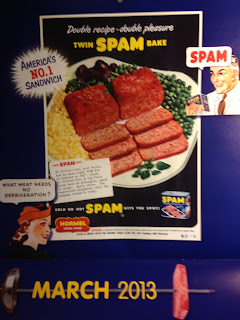“Twelve Months of SPAM”
c. 2012 Rod Ice
All rights reserved
(1-13)
As I have observed here
before, the best columns seem to write themselves.
A recent example of this
truism appeared when my I received a unique calendar from my sister and her
family, for Christmas. It was composed of old ads for the well-known dinner-in-a-blue-can,
called SPAM.
George A. Hormel first
established his Minnesota-based company in 1891. After years of successfully
selling meat products, he introduced the world’s first canned ham in 1926. The debut
was an omen of sorts, hinting at future glory for his firm. Eleven years later,
the company created SPAM, the “new Hormel meat.”
Colorful phrases peppered
company literature, using the lingo of an emerging hipness in domestic style.
“Cold or hot,” Hormel promised, “SPAM hits the spot!”
The calendar I received
used promotional material from the classic, late 1940’s period. After World War
II, American consumers were literally hungry for products of all kinds. SPAM
was offered as the centerpiece for a variety of new meal creations. Yet the
themes reflected a kind of dietary rowdiness that would not translate into
modern terms.
There was no gastronomic
correctness in that bygone era. Instead, the full-flavored dishes suggested by
Hormel were unafraid of sodium and saturated fats:
SPAM ‘n’ Limas (January 2013 page)
“Make a Spanish sauce of canned tomatoes, chopped
onions, green peppers and celery leaves with a little salt, sugar, lard. Add to
fresh or frozen precooked limas in casserole, partly bury 8 or 10 slices of
SPAM in top, garnish with pimiento squares and bake 25 minutes at 350 degrees.”
Imagine... adding lard to
SPAM? Remember, this was the Baby-Boom era.
Hormel also tried to push
the product as perfect for those seeking lighter meal alternatives. Cold-and-straight-from-the-can,
this lovable meat-brick was offered as a perfect way to dine on a hot, summer
day:
SPAM ‘n’ Salad (February 2013 page)
“Chill SPAM and cut generous slices just as it comes
from the can. Add an old fashioned tomato-cucumber-lettuce salad... spiced
apples for contrast... and you can offer the family an attractive, delicious
luncheon or supper... ready in a jiffy.”
The “in a jiffy” part was
undeniably important, as America was getting back to work after years of
conflict in Europe and Asia. Soldiers coming home were used to such canned
foods. Meanwhile, homemakers eagerly accepted them as economical and easy to
use.
The company even dared to
pair their metal-clad meat with fruit:
Fiesta Peach SPAM Bake (May 2013 page)
“Golden-ripe cling peaches from California bake with
savory pure-pork SPAM for a memorable main dish. It’s easy to fix. Simply drain
a No. 2 ½ can cling peach slices, saving syrup. Slice a whole SPAM almost, but
not quite, through, into 5 sections. Place in shallow baking dish. Insert
peaches between the SPAM slices. Arrange remaining peaches around SPAM. Pour
over ¼ cup peach syrup, blended with 2 tbsp. brown sugar. Stud with cloves.
Bake at 375 degrees about 35 minutes.”
In the late 40’s, Jay C.
Hormel introduced a traveling troupe of sixty entertainers called the “Hormel
Girls.” They appeared across the nation, and had a top-rated weekend program on
various radio networks. Known to travel in a fleet of matching Chevrolets, they
were originally comprised of military veterans. All were subject to strict
rules for appearance and conduct. The ladies marched, sang, danced... and sold
SPAM.
Hormel pursued an
aggressive business strategy that yielded great success. In recipe terms, they
followed the same path, suggesting ideas like wood-plank-grilling years before
they became known to most Americans:
Planked SPAM (June 2013 page)
“Score a whole SPAM and rub with brown sugar. Surround
it on the plank with tomato slices capped with large mushrooms doused in butter.
Bake 25 minutes in hot oven, then ring with mashed potatoes and slip back in
the oven for quick browning. Bring to table, plank and all... and be greeted
with cheers.”
My calendar concluded with
a fireworks salute of rapid-fire images. A festive SPAM Summer Platter, with
sliced meat, tomatoes stuffed with lettuce, celery stalks, and Swiss cheese. SPAM
with pancakes, or waffles. SPAM and baked beans. A California SPAM-burger
served on a bun with sliced tomato, onion, and melted cheese. SPAM with scalloped
potatoes. Baked SPAM studded with cloves, then basted with a sauce made of
vinegar, brown sugar, mustard and water. Even SPAM spaghetti.
In addition to kitchen
concoctions, one vintage ad urged restraint when the tinned meat was
temporarily unavailable:
Don’t Blame Your Grocer (October 2013 page)
“Don’t blame your grocer when he’s out of SPAM. Jack
Thompson, Hormel man now with anti-aircraft battery, writes of the amount of
SPAM being used by the armed forces: ‘Because I am far away doesn’t mean I am
missing Hormel meats. We have SPAM quite often here.’”
Quite often, I wondered?
Like every day for weeks and months on end?
The enduring appeal of
SPAM cannot be denied, in modern terms. Even by those who avoid such undisciplined
dietary abandon. Hormel hit a homerun in 1937. And that blue ball is still
soaring, today... over Geauga County, USA, and the world.
Comments about Thoughts At Large may be sent to:
icewritesforyou@gmail.com
Visit us at: www.thoughtsatlarge.com



0 Comments:
Post a Comment
<< Home